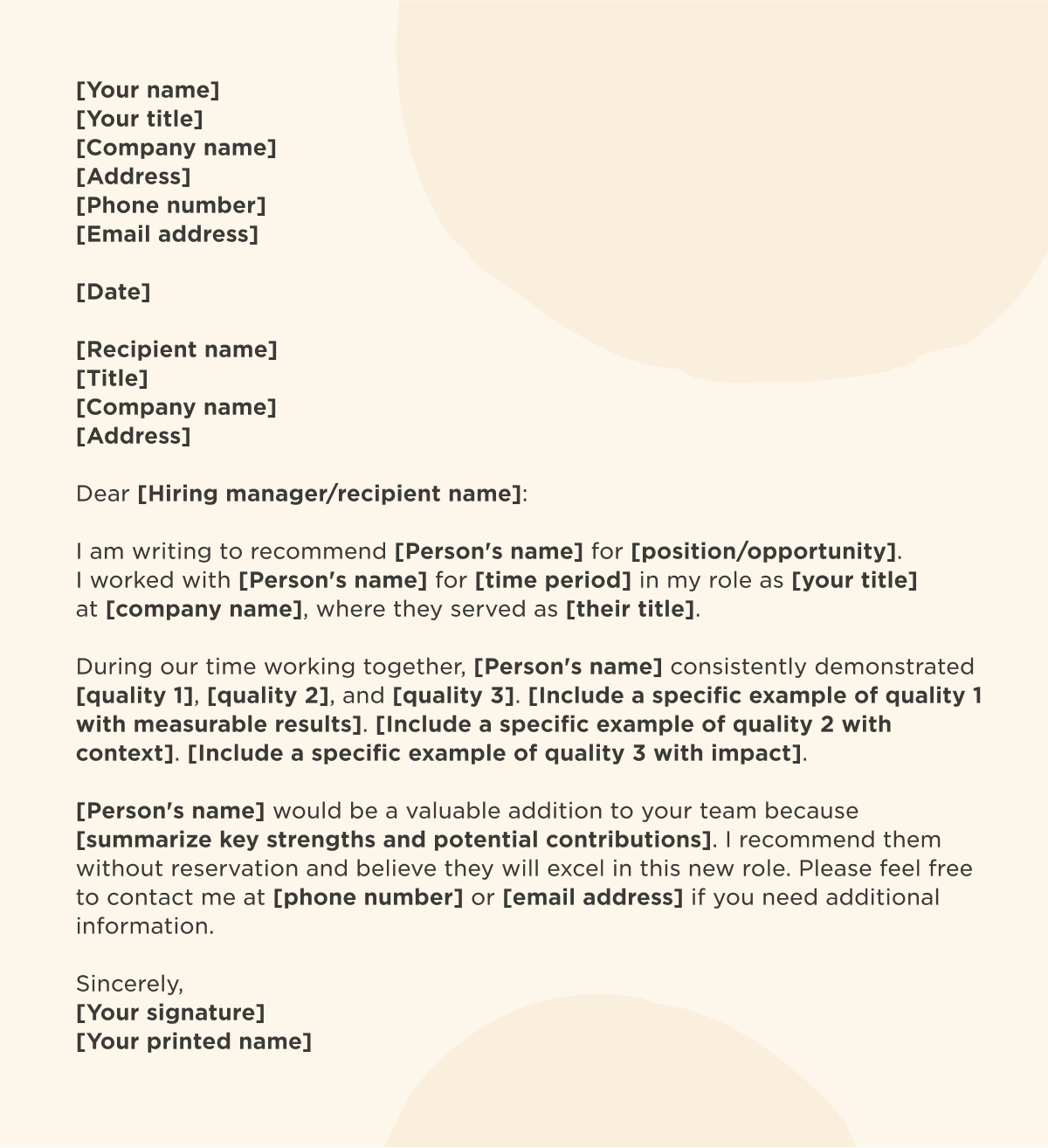When a valued team member moves on, writing a reference letter can be one of the most meaningful ways to support their next step. Whether they’re applying for a new role, joining a board, or pursuing further education, a well-crafted reference can help decision-makers move forward with confidence.
In this guide, we’ll walk you through how to write a strong, legally sound reference letter that reflects your appreciation and respects the person’s contributions. You’ll also find a downloadable reference letter template and a real-life sample to help you get started.

How to write a reference letter
HR professionals write reference letters to help former team members land their next opportunity. These letters serve as meaningful endorsements, highlighting the person’s skills, character, and contributions in a way that hiring managers can trust.
As HR expert Susan M. Heathfield points out, “Recognition is not a scarce resource. You can’t use it up or run out of it.” A reference letter is exactly that—a form of recognition with real impact. It goes beyond a resume to offer insight into how someone works, collaborates, and adds value to a team.
Writing an effective reference letter requires a balance of honesty and support. You want to provide helpful, specific information that reflects well on the person while avoiding language that could overpromise or create confusion.
Here’s how it works:
1. Gather information
Start by collecting comprehensive details about the person you’re recommending to ensure accuracy and completeness. Review their employee files to confirm:
- Employment dates: Exact start and end dates
- Job titles: All positions they held during their tenure
- Key responsibilities: Primary duties and areas of focus
- Notable achievements: Specific accomplishments with measurable results
- Performance reviews: Documented feedback and ratings
2. Highlight two to three qualities with specific examples
Focus on two to three qualities that are most relevant to the opportunity the person is pursuing, rather than trying to cover every aspect of their performance. Choose traits like leadership, problem-solving, or technical expertise, and connect each one to a concrete example from your experience working together.
Specific stories bring these qualities to life and make your letter more memorable than generic praise. For instance, instead of writing “John is a good leader,” describe how John coached a team through a difficult project, improving efficiency and morale. If they’re applying for a technical role, you might highlight how they solved a complex systems issue with measurable results.
This approach—quality over quantity—creates a stronger, more credible recommendation and gives hiring managers the evidence they need to quickly understand the person’s potential value.
3. Provide helpful context
Establish your credibility and relationship with the person early in the letter to help readers understand your perspective. Clearly state your job title, how long you worked together, and in what capacity. This context helps readers evaluate the weight and relevance of your observations.
Include details about the work environment and team dynamics when relevant to provide a complete picture of their performance. For example, you might explain that you directly managed the person for three years on a small team of five, giving you insight into how well you observed their skills.
Recommended For Further Reading
4. Stay legally compliant
Staying compliant means understanding the legal boundaries. It’s safest to stick to basic details such as job title and employment dates unless the person’s conduct posed a safety risk. To reduce liability, attorney Sage Knauft recommends to HR Magazine that “All disclosures should be made only in writing and only upon written request from the prospective employer and with written permission from the employee.”
To stay consistent and protect both the organization and the individual, reference requests should be handled by HR or another designated point of contact. Apply the same process for every request to prevent discrimination claims, and always check applicable state laws in all relevant jurisdictions. When in doubt, consult legal counsel—especially if the departure was complicated or performance-related.
5. Include contact information
Provide multiple ways for potential employers to reach you for follow-up questions or verification. Include your current job title, company name, phone number, and professional email address.
Specify your preferred contact method and typical availability to facilitate smooth communication.
6. Maintain professionalism
A professional presentation reflects positively on both you and the person you’re recommending. Review the letter for grammar, spelling, and formatting consistency before sending.
Ensure it maintains a professional tone throughout and follows standard business letter formatting. Keep the length appropriate—typically one to two pages—to respect the reader’s time while providing enough detail.
A polished, error-free letter demonstrates attention to detail and professionalism that reflects well on your organization.
Downloadable reference letter template
Use this customizable template to streamline your reference letter writing process while ensuring you include all essential elements:
[Your name]
[Your title]
[Company name]
[Address]
[Phone number]
[Email address]
[Date]
[Recipient name]
[Title]
[Company name]
[Address]
Dear [Hiring manager/recipient name]:
I am writing to recommend [Person’s name] for [position/opportunity]. I worked with [Person’s name] for [time period] in my role as [your title] at [company name], where they served as [their title].
During our time working together, [Person’s name] consistently demonstrated [quality 1], [quality 2], and [quality 3]. [Include a specific example of quality 1 with measurable results]. [Include a specific example of quality 2 with context]. [Include a specific example of quality 3 with impact].
[Person’s name] would be a valuable addition to your team because [summarize key strengths and potential contributions]. I recommend them without reservation and believe they will excel in this new role.
Please feel free to contact me at [phone number] or [email address] if you need additional information.
Sincerely,
[Your signature]
[Your printed name]
<<Download our free reference letter template.>>
What to avoid including in a reference letter
Understanding what to exclude from reference letters protects both you and your organization from potential legal complications while maintaining professional standards. Avoid including:
- Personal information or irrelevant details: Keep content focused on professional performance and work-related qualities rather than personal characteristics or circumstances. As Knauft shared with SHRM, “Avoid giving opinions about the employee’s suitability for a prospective job and use only documented evidence to share information related to an employee’s job performance.”
- Negative comments: Decline to write a letter rather than include criticism since negative reference letters can create legal liability and damage relationships.
- Exaggerations: Maintain honesty and accuracy in all statements since false information can harm your credibility and the person’s reputation.
- Protected characteristics: Avoid mentioning age, gender, race, religion, or other protected characteristics that could create discrimination concerns.
- Confidential information: Respect company privacy policies and avoid sharing sensitive business information or proprietary details.
Reference letter example
Here’s a complete reference letter that demonstrates best practices and incorporates the elements we’ve discussed:
Sarah Johnson
Director of Marketing
TechStart Solutions
123 Business Ave, Suite 400
Boston, MA 02101
(555) 123-4567
[email protected]
March 15, 2024
Michael Chen
Hiring Manager
Innovation Labs Inc.
456 Tech Parkway
Cambridge, MA 02139
Dear Mr. Chen:
I am writing to recommend Alex Rodriguez for the Senior Marketing Specialist position at Innovation Labs. I worked directly with Alex for two years in my role as Director of Marketing at TechStart Solutions, where they served as Marketing Coordinator from January 2023 to December 2024.
During our time working together, Alex consistently demonstrated exceptional analytical skills, creative problem-solving abilities, and outstanding project management capabilities. When we launched our new product line, Alex developed and executed a comprehensive digital marketing strategy that increased lead generation significantly within three months. They also spearheaded our social media campaign redesign, which improved engagement rates substantially and contributed to increased brand awareness according to our quarterly surveys.
Alex’s ability to collaborate across departments made them invaluable to our team. They worked closely with our sales team to align marketing messages with customer feedback, resulting in more targeted campaigns and improved conversion rates. Their attention to detail and proactive communication style helped us complete every project on time and within budget.
Alex would be a valuable addition to your marketing team because they combine strategic thinking with hands-on execution skills. I recommend them without reservation and believe they will excel in this new role at Innovation Labs.
Please feel free to contact me at (555) 123-4567 or [email protected] if you need additional information.
Sincerely,
Sarah Johnson
Build strong connections with this reference letter template
Reference letters represent more than administrative tasks—they’re opportunities to strengthen professional relationships and support career growth within your network. Writing thoughtful, detailed letters demonstrates your commitment to people’s success beyond their time with your organization.
The investment you make in writing quality reference letters often comes back to benefit your organization through positive word-of-mouth, stronger industry relationships, and a reputation as an employer that genuinely cares about people’s career development.
<<Write strong reference letters with this free template.>>
Reference letter FAQs
What is the difference between a reference letter and a recommendation letter?
A reference letter gives a broad overview of a person’s skills, character, and work ethic, often without being tied to a specific role. A recommendation letter goes a step further by endorsing the individual for a particular job or opportunity and providing examples that match that role. Employers typically view recommendation letters as stronger because they are more targeted, but both can be valuable depending on the context.
How long is a professional reference letter typically?
Most reference letters fall between one and two pages. This length provides enough space to highlight key qualities and give concrete examples without losing the reader’s attention. Aim for a few focused paragraphs.
Can HR professionals refuse to write a reference letter?
Yes, HR professionals can decline if they don’t feel they can provide an accurate or positive assessment. It’s also common for company policy to limit references to basic employment verification, like dates of service and job titles. In those cases, it’s better to politely explain the limits upfront rather than provide a weak or negative letter.
Do reference letters include salary information?
No, reference letters generally exclude salary details. Compensation is considered confidential and isn’t relevant to evaluating someone’s skills or contributions. Instead, the focus should stay on professional achievements, qualities, and work performance.
